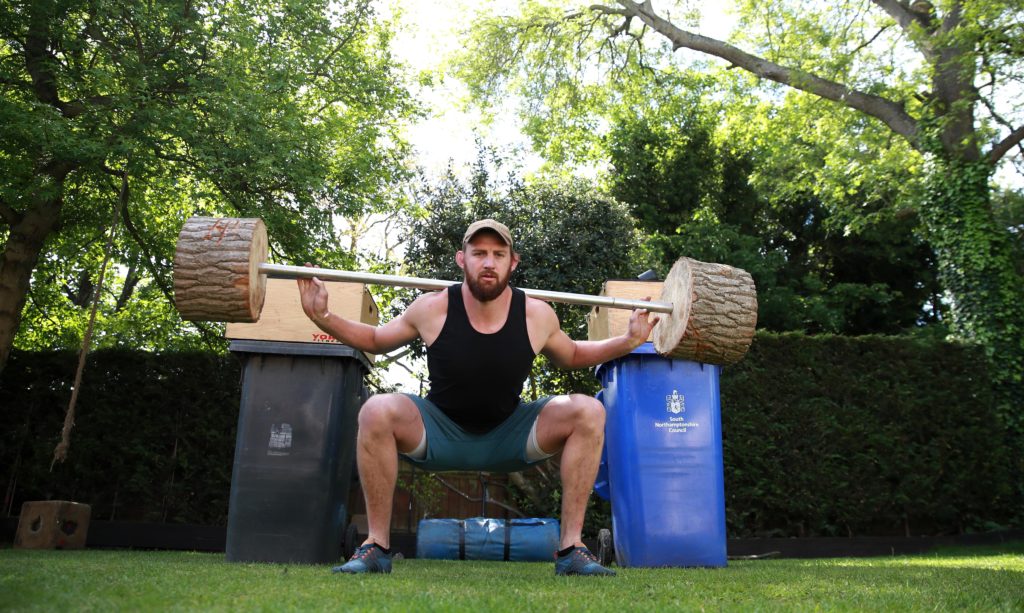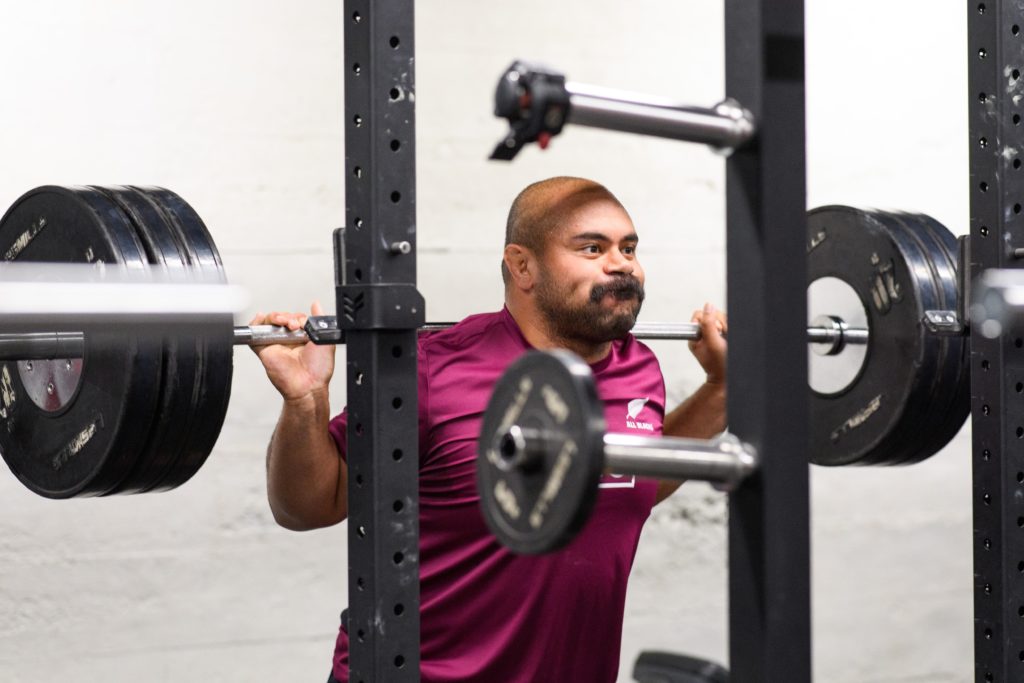How do you replicate a rugby tackle when you’re stuck in the house by yourself?
This is not a metaphysical riddle but a pertinent question strength and conditioning coaches asked themselves during the early stages of the coronavirus pandemic. As professional sport joined the rest of the world in lockdown, those responsible for keeping elite rugby players in prime shape were forced to adapt.
“The truth is there is no way to accurately mimic that collision of bodies,” says Daniel Tobin, head of strength and conditioning at English Premiership outfit Gloucester. “We had to accept that there were going to be losses across a variety of areas. We expected falls in strength, speed and power. Our primary job was to mitigate that as best we could.”
In the absence of body-to-body contact, Tobin had his players undergo exercises that saw them drop to the ground and get back up as quickly as possible. Bear crawls were thrown into the mix as were prolonged high-intensity jumping spells.
We basically had a draw to see who would get which kit. The injured players were prioritised.
Huw Davies, Scarlets
“You can produce a lot of force and a lot of power with your own bodyweight,” Tobin explains. “The impact of landing is a high-force movement. These programmes did save us to a degree. The guys weren’t as far behind as we thought they’d be when we finally got them back.”
Jumps may jolt muscles and bones, but bulging biceps and thick thighs need more substantial matter to bulk up. With players unable to go to the gym, clubs did what they could to get the gym to their players.
“We basically had a draw to see who would get which kit,” says Huw Davies, who runs the strength and conditioning programme at Welsh region, Scarlets. “Of course it was a little more sophisticated than pulling random names out of a hat.
“The injured players were prioritised as we couldn’t afford to let their rehabilitation slip. And the bigger weights went to the guys who could actually lift them. But it was a bit random. We tried to get everyone enough kit to complete a comprehensive programme.”

The Welsh Rugby Union chipped in to assist nationally contracted players. Some already had their own gear to hand which helped too. But by and large, training during lockdown was a mishmash of regimes. In the Western Cape in South Africa, the Virgin Active health club loaned out cardio equipment. But it wasn’t a like-for-like replacement.
“We had to become innovative in the way we planned our programmes due to the unique restrictions our players faced,” says Riefaat Jappie, a strength and conditioning coach at the Stormers and Western Province in Cape Town. “We had to work around the space they had available and their unique situation.
“Everyone’s daily routine is so different. We had farmers that will train early in the morning to get it done and then go to work on the farm. Then there are guys who live on their own who are into their gaming and sleep later in the day. Then the married ones and the fathers who trained around their family time. We as strength and conditioning coaches were in new territory.”
There’s just nothing like approaching a monster weight at the gym. Everyone is watching you.
Daniel Tobin, Gloucester Rugby
Two central challenges emerged. The first had to do with the amount of time players would be confined to their homes.
“We were going a week at a time,” Tobin says. “We didn’t know how long it would be. Initially we thought players would be home for two or three weeks and then we’d be able to crack on.”
As the contrasting reality came into focus, strength and conditioning coaches had to reimagine how to keep their players engaged. With so much of their world now constrained to the same physical space, variety was sorely needed in their routines.
“With limited equipment, there really is only so much you can do,” Davies says. “We’d change even the smallest things just to keep it fresh. If a player did forward lunges one week he’d do reverse lunges the next week. We were very conscious of our players getting bored. They’re professionals but it was still important that they were excited to train.”
Not that the lack of variety was necessarily a hindrance to the conditioning of players. Lifting heavy weights exhausts fast-twitch muscle fibres which leads to power gains. But this can still be achieved with a lighter weight such as a 20kg kettlebell or dumbbell with high reputations.
 All Blacks” class=”wp-image-9738″ />
All Blacks” class=”wp-image-9738″ />By understanding the biomechanics of the human body, strength and conditioning coaches ensured that their players returned in pretty much the same shape in which they left them.
That is not to say that heavy weights and expensive machines have now been cast to the scrapheap. While muscle fibres and tendons can’t tell the difference between a 20kg kettlebell lunge and a 160kg squat, our brains certainly can.
“There’s just nothing like approaching a monster weight at the gym,” Tobin says. “Everyone is watching and you hype yourself up as best you can. There is a bit of fear in there as well which is good. That gives you that testosterone spike in the moment. For want of a better term, you’re forced to man up and get the job done.
“All those factors – the psychological, the hormonal – are important for the game as well. So even though you can get a reasonably similar stimulus with smaller weights, the extra component that compels you to fight on the field is honed in the gym.”
There were some obstacles that both strength and conditioning coaches and their players encountered that couldn’t be measured with a scale or stopwatch. Not only are these practitioners responsible for the physical wellbeing of others, they also serve as de facto therapists. Like a bartender at the local watering hole, or the barber at the family-run salon, there are some professions that encourage honest conversation.
Siya had to isolate for 10 days. I had to meet him away from the squad and follow strict protocols. I could only keep a stopwatch.
Riefaat Jappie, The Stormers
“I think the relationship with my players has grown over this period,” Jappie says. “During lockdown I had to be in contact with each player daily to get training logs of what they were doing, what was working and what was not.”
Jappie pinpoints a particular example in which he was in constant dialogue with Springbok captain Siya Kolisi. The back-row was isolating separately from his wife, Rachel, who had contracted Covid-19:
“Siya had to isolate for 10 days. Then when that ended he had to isolate again for 10 days but we couldn’t afford for him to do nothing as we needed him once he was cleared. I had to meet him away from the squad and had to follow strict protocols. I had to keep my distance and could only keep a stopwatch. If he used any equipment, I had to sanitise and deep clean it thoroughly.”
It’s not just World Cup-winning skippers who received extra attention. Rugby’s self-aggrandising mythology leans on notions such as brotherhood and togetherness, but institutions great and small have demonstrably come together over this tumultuous past year.

“It’s a family environment,” Davies adds, speaking of the duty of care that he feels for his players and staff. “A lot of these guys lived alone and had most of their meals prepared by the club during the week so they had to up their cooking skills. It was a challenging time but we all pulled in together.”
Tobin, whose Gloucester colleagues navigated the extra variable of a change of head coach during the pandemic, encapsulates the dual responsibility he assumed in these unprecedented times.
“For a lot of the guys, especially the ones on their own, that session together would be the most significant thing they did in their day. I had to be conscious to check in to see if they were doing OK. We didn’t always get it right. Once we got back together I realised I could have done more for certain guys. But you only realise that with hindsight.”
Once lockdown was lifted, and a restart date was circled on the calendar, strength and conditioning coaches could get back to their primary task. But not without other changes. Every bit of equipment – from weight plates to benches – had to be wiped down and sanitised after every use. Masks were mandatory. Even the way players were spotted had to change as coaches couldn’t stand over them and had to maintain distance.
We have added an hour or so to our work day, but for the benefits we’re seeing, it’s been worth it.
Daniel Tobin, Gloucester Rugby
It wasn’t all bad, though. With the size of training groups reduced, individual players received extra attention. This allowed them to work closely with coaches and fast-track their return to peak conditioning.
“We’ve actually decided to keep working in smaller groups as a result,” Tobin says. “Our coaching has improved and there is less of a group mentality. We can cater to the specific needs of our players in much more detail now. It means we have added an hour or so to our work day, but for the benefits we’re seeing, it’s been worth it. I know other teams feel the same way.”
Tobin, like Jappie and Davies, was in constant contact with counterparts at rival clubs. All three speak of the sense of fraternity that strength and conditioning coaches feel for one another. The vanity of small differences might provide a competitive edge, but when the future looked bleak and the world was a less certain place, a common thread pulled these men together.
“There was a lot of collaboration,” Davies says, echoing sentiments expressed by Tobin and Jappie. “It was a challenge for all of us as there wasn’t a blueprint we could turn to. We swapped notes and asked each other questions. Ultimately, we’re all in this for the same reason. It was encouraging to see that willingness to exchange ideas.”
That rugby has continued amid the chaos is a testament to every individual involved. But special praise must be reserved for those strength and conditioning coaches who have sculpted and healed players through this trying time. Without them, the entire spectacle would have been impossible.
If you’ve enjoyed this article, please share it with friends or on social media. We rely solely on new subscribers to fund high-quality journalism and appreciate you sharing this so we can continue to grow, produce more quality content and support our writers.


Comments
Join free and tell us what you really think!
Sign up for free